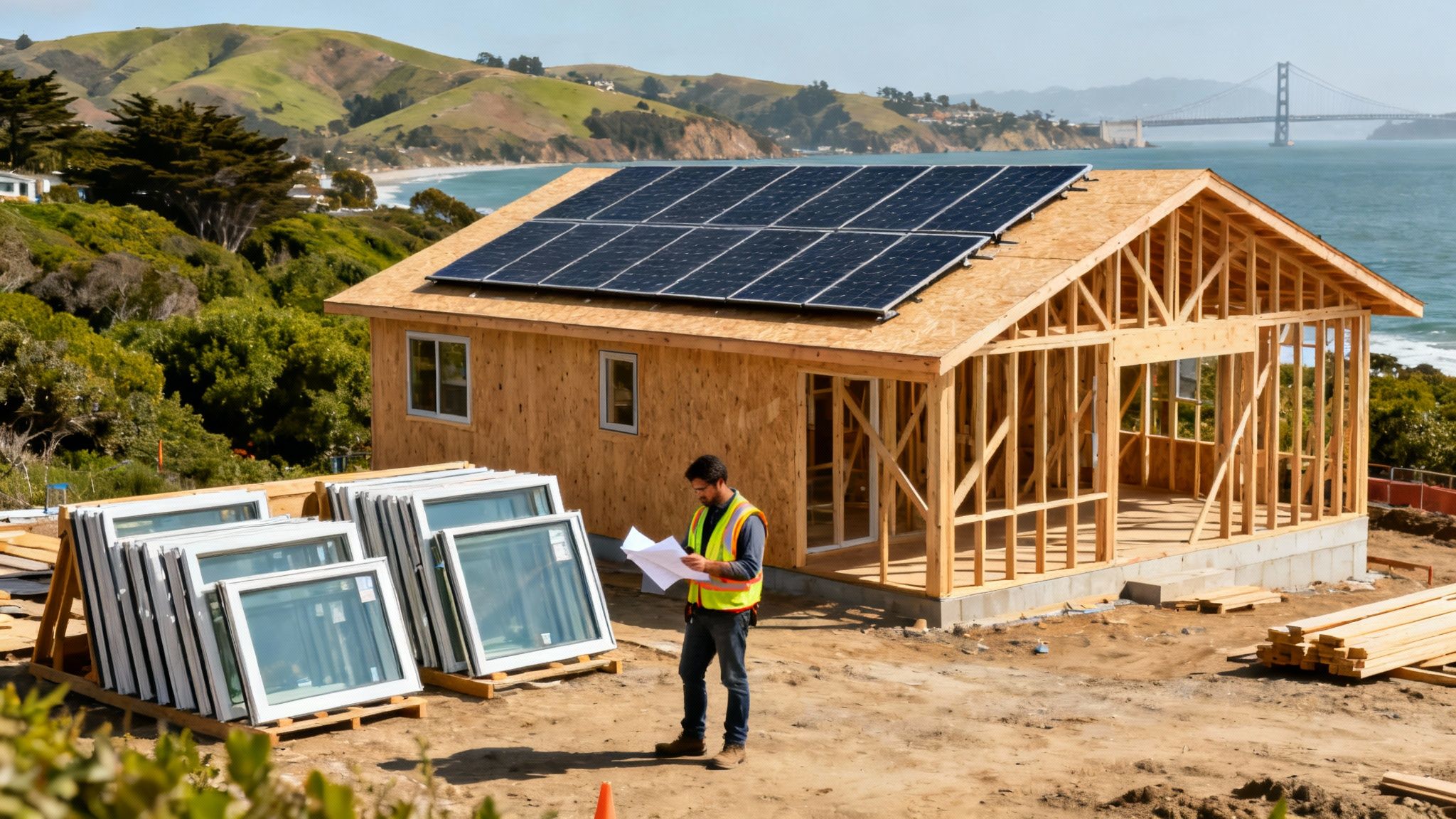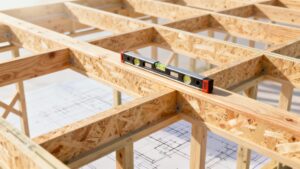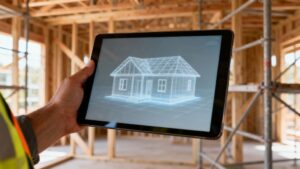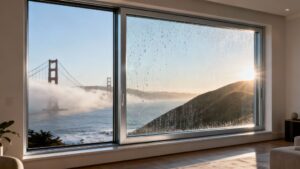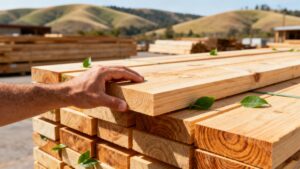Building green in the Bay Area isn't just a trend anymore. It's a core requirement for almost every construction project. The path to a final permit now goes directly through California's Title 24 energy code and CALGreen standards.
These regulations set the rules for everything. This includes insulation, window performance, and even how you manage construction waste. Understanding these evolving standards is critical for getting projects approved without costly delays.
Why Green Building is Now Standard Practice in the Bay Area
California continues to lead the nation in environmental policy, and the Bay Area is at the forefront. Local codes push builders toward more sustainable practices, from energy-efficient windows to FSC-certified lumber. These standards are fast becoming baseline expectations for every new build or remodel in Berkeley, Oakland, and San Francisco.
For contractors, architects, and homeowners, these choices directly affect project approvals and long-term value. Navigating regulations like Title 24 updates has become more complex. Consumers are also more informed, raising the bar for product selection.
Want to learn more about the basics? Check out our guide on what sustainable building entails.
The Driving Force Behind Local Green Codes
California’s leadership in green building has reshaped how we work. Codes like Title 24 and CALGreen have set aggressive sustainability goals. As a result, contractors must use better materials and more efficient systems to stay competitive.
A few key regulations drive most decisions for builders. It's essential to understand the "what" and "why" behind each one. This helps you plan your projects effectively.
Here’s a quick breakdown of the main rules you'll see on almost every job site in the Bay Area.
Key California Sustainability Mandates at a Glance
| Regulation | Primary Focus | Key Requirement Example for Bay Area Projects |
|---|---|---|
| Title 24, Part 6 | Energy Efficiency | High-performance windows (low U-factor/SHGC), mandatory insulation levels, and standards for HVAC and lighting systems. |
| CALGreen | Holistic Sustainability | Water-efficient fixtures, construction waste diversion (65% minimum), and low-VOC materials for better indoor air quality. |
| Local "Reach" Codes | Advanced Local Standards | Many cities like Berkeley have stricter rules, such as requiring all-electric new construction or EV charging infrastructure. |
These codes ensure every new building helps California meet its energy conservation goals. This pushes the entire industry forward.
The big takeaway is that sustainability is no longer optional—it’s embedded in design decisions. Two-thirds of architects now say product quality and sustainability are top priorities.
Your Expert Partner in Sustainable Construction
Meeting these high standards requires a supply partner who understands the local landscape. They need to have the right materials to match.
At Truitt & White, we offer a curated inventory of green building products. This includes FSC-certified wood and energy-efficient windows. Our team provides local guidance on what qualifies under California codes. We are a trusted partner for sustainable Bay Area projects.
Getting a Handle on Title 24 and CALGreen
If you’re a builder in the Bay Area, you live by California’s building codes. Two regulations in particular dictate how we build. These are Title 24, Part 6 (the Energy Code) and CALGreen (the California Green Building Standards Code).
Title 24 is the energy specialist. It focuses on the building's thermal envelope—insulation, windows, and air sealing. It also sets efficiency standards for lighting and HVAC systems.
CALGreen looks at the bigger picture. It covers water conservation, construction waste, and indoor air quality. It ensures a home is not just efficient, but also healthier and smarter with its resources.
Decoding Title 24 for Bay Area Projects
Title 24 gives you two ways to prove compliance. You can follow the prescriptive path or the performance path.
The prescriptive path is like a recipe. It gives you a checklist of specific requirements for insulation, windows, and HVAC. It’s simple but offers little design flexibility.
The performance path is more flexible. An energy consultant uses software to create a custom energy budget for the home. This lets you make trade-offs, like using better windows to balance less wall insulation.
Remember: the Bay Area covers multiple climate zones. A project in foggy San Francisco (Climate Zone 3) has different window requirements than a job in Walnut Creek (Climate Zone 12). Always verify the specific rules for your job site's location.
Key Mandates of CALGreen
While Title 24 focuses on energy, CALGreen enforces other mandatory measures. These apply to all new construction and major remodels.
You'll need to plan for:
- Construction Waste Diversion: You must divert at least 65% of all construction and demolition waste from landfills. This means recycling wood, metal, drywall, and concrete.
- Water Efficiency: The code requires high-efficiency plumbing fixtures. This includes low-flow toilets, faucets, and showerheads to reduce indoor water use.
- Low-VOC Materials: To protect indoor air quality, CALGreen requires paints, adhesives, and flooring with low or zero volatile organic compounds (VOCs).
- Ventilation and Air Quality: The code mandates proper mechanical ventilation. This ensures a constant supply of fresh air, reducing indoor pollutants.
These rules directly impact the products you buy. For Title 24, you need windows with certified NFRC labels. For CALGreen, you need low-VOC finishes and a good waste management plan.
This is where a knowledgeable supplier makes a difference. The team at Truitt & White in Berkeley knows the specific code requirements for projects in Oakland, Berkeley, and across the Bay Area. We can help you source the compliant materials you need.
Designing a High-Performance Building Envelope
Your building envelope is the most important factor in meeting California's energy standards. It includes your walls, roof, foundation, windows, and doors. It is the barrier between the indoor space and the Bay Area's microclimates.
A high-performance envelope does two things well. It keeps conditioned air in and unwanted air out. This means creating a structure that is both highly insulated and extremely airtight.
Advanced Framing and Continuous Insulation
Successful builders often use advanced framing techniques. This approach uses less lumber, which reduces thermal bridging—heat transfer through the studs. Less wood means more room for insulation.
Paired with advanced framing, continuous insulation is a game-changer. This involves applying an uninterrupted layer of insulation to the exterior. It wraps the building in a blanket, boosting the wall's R-value. Learn more by reading our guide to understanding R-value in insulation.
This infographic shows the core pillars of California's green building codes. It starts with the all-important building envelope.
As you can see, a high-performance envelope is the first and most critical step. It directly impacts a home's energy use for its entire life.
The Critical Role of Windows and Doors
Windows and doors are potential weak points for energy loss. Under Title 24, window performance is strictly regulated.
Every window and glass door must have a National Fenestration Rating Council (NFRC) label. This label shows two key numbers:
- U-factor: Measures how well the window stops heat from escaping. A lower U-factor means better insulation.
- Solar Heat Gain Coefficient (SHGC): Measures how much solar heat is blocked. A lower SHGC is vital for warmer inland areas to prevent overheating.
Choosing the right window is more than meeting code. A high-quality window from brands like Marvin or Andersen offers better construction, air sealing, and durability.
Achieving Airtightness with Modern Air Barriers
Airtightness is a major focus of California’s energy code. A leaky house wastes energy by forcing HVAC systems to work harder. Builders must now meet specific air leakage targets, verified by a blower door test.
Hitting these targets requires a systematic approach to air sealing. Modern air barriers are key.
These systems include:
- Fluid-applied membranes: Rolled onto the exterior sheathing to create a seamless barrier.
- Self-adhered membranes: A robust, full-coverage layer over the sheathing.
- High-performance tapes: Used to seal every seam and the tricky spots around windows and doors.
Sourcing these materials from a knowledgeable supplier is crucial. At Truitt & White, we stock the air sealing products, windows, and doors that Bay Area builders need. Our team can help you specify the right products to pass inspection.
Going All-Electric and Tapping into Renewables
California is leading the move toward all-electric homes. For Bay Area builders, this is the new reality. Shifting from natural gas to high-efficiency electric systems is a core part of building green here.
The key is to plan for electrification from the start. Integrating systems like heat pumps, solar panels, and EV chargers from day one helps you avoid expensive retrofits. This forward-thinking approach is what it takes to build Zero Net Energy (ZNE) homes.

The Rise of High-Efficiency Heat Pumps
Heat pumps are the workhorses of the all-electric movement. They handle heating, cooling, and hot water. They don't burn fuel; they simply move heat, making them incredibly efficient.
For Bay Area homeowners, the benefits are clear:
- Superior Efficiency: A modern heat pump can be up to 300% more efficient than a typical gas furnace, leading to lower energy bills.
- Improved Indoor Air Quality: Eliminating natural gas combustion inside the home makes the living space healthier.
- Dual-Function Performance: One system handles both heating and cooling, simplifying mechanicals.
Meeting the Solar Mandate
Renewable energy is non-negotiable in California. State code now requires solar panels on most new homes. This mandate has pushed rooftop solar forward, with over 1.2 million homes having panels as of 2025. You can learn more about the top green building trends for California contractors on contractorexamschools.com.
Title 24 offers some flexibility. You can size the solar system based on the home’s projected energy use. You can also install a smaller system if you pair it with battery storage for backup power.
A common myth is that solar only works in very sunny places. Modern panels are very efficient and generate plenty of power even on foggy San Francisco days.
EV Charging: The New Standard
The latest building codes have made EV charging a "must-have." The code now requires installing a Level 2 EV charger for every new dwelling unit.
This change impacts project planning:
- Electrical Panel Sizing: The main panel must handle the extra load from a Level 2 charger, which needs its own 40- or 50-amp circuit.
- Location and Layout: The charger needs a designated spot in a garage or parking area.
- Client Education: Homeowners need to understand how their new charging system works.
By integrating these all-electric and renewable systems, you deliver a superior product. The home will be more efficient, healthier, and more valuable.
Sourcing Sustainable Materials for Green Certifications
Meeting the energy code is one thing. Truly building green in the Bay Area means getting serious about your material choices. This involves specifying materials like FSC-certified lumber, reclaimed wood, and low-VOC paints.
These decisions directly impact indoor air quality and help you earn certifications. Programs like LEED and GreenPoint Rated add real market value. They attract environmentally-aware buyers in our local market.

Materials That Earn Certification Points
Getting a project certified is a game of points. Your material selections are a great way to earn them.
Here are key material categories that help you score big:
- Sustainably Harvested Wood: Using Forest Stewardship Council (FSC) certified lumber is a great way to earn points. The FSC label guarantees the wood comes from responsibly managed forests.
- Recycled and Reclaimed Content: Specifying materials with high recycled content is a huge win. This includes engineered wood, some types of insulation, or countertops.
- Low-Emitting Materials: To earn indoor environmental quality credits, use products with low or zero Volatile Organic Compounds (VOCs). This applies to paints, sealants, adhesives, and flooring.
- Regional Sourcing: Green building programs reward you for sourcing materials locally. This cuts down on transportation emissions and supports the local economy.
For more on sustainable wood, see our guide on finding an eco-friendly lumber supplier in the East Bay.
The Growing Value of Third-Party Certifications
In a market like the Bay Area, a green building certification helps you stand out. It’s third-party proof that a home is healthier, more efficient, and built better than code requires. This has a real impact on a property's value.
Certifications like LEED (Leadership in Energy and Environmental Design) are a big deal here. In our region, LEED is often a requirement for public and private projects. You can get more details on these green building trends at CommercialSearch.com.
Here's a quick look at common certifications.
Popular Green Building Certifications in the Bay Area
| Certification | Main Focus | Best For… | Example Credit Area |
|---|---|---|---|
| LEED | Comprehensive sustainability and energy efficiency. | Commercial projects, high-end custom homes, and public buildings. | Optimizing Energy Performance |
| GreenPoint Rated | Residential-focused, tailored to California climate and regulations. | Single-family homes, multi-family units, and residential remodels. | Water Conservation (Indoor/Outdoor) |
| Living Building Challenge | The most rigorous standard; aims for regenerative buildings. | Ambitious projects aiming for net-zero or net-positive impact. | Sourcing materials with "Red List" free ingredients. |
| Passive House (PHIUS) | Ultra-low energy use through a tight building envelope and ventilation. | Projects where energy efficiency and comfort are the top priorities. | Airtightness and Thermal Bridge Free Design |
Each program has its own rules and paperwork.
Navigating the paperwork for certification programs can be a headache. Partnering with a supplier who understands the documentation can save you countless hours.
A knowledgeable supplier like Truitt & White can point you to products that meet these tough standards. We help ensure your work stands out for all the right reasons.
Your Partner for Sustainable Bay Area Construction
Meeting California’s evolving sustainability standards takes planning and collaboration. It requires a deep understanding of how material choices affect project outcomes. The secret to building green in the Bay isn't just knowing the rules—it's knowing how to meet them on time and on budget.
At Truitt & White, we are more than a lumberyard. We are a dedicated resource for the Bay Area's builders, architects, and remodelers. Our team understands local codes and can turn complex regulations into straightforward solutions for your jobs.
Expert Guidance for Complex Projects
We understand the pressure you're under. We know that two-thirds of architects say product quality and sustainability are top priorities. Our job is to make the process of choosing materials easier.
We can help with practical, on-the-ground advice for:
- Product Selection: Identifying the right energy-efficient windows for your specific climate zone.
- Code Compliance: Sourcing the FSC-certified lumber and low-VOC finishes you need to meet CALGreen mandates.
- Certification Support: Choosing materials that contribute points toward certifications like LEED or GreenPoint Rated.
Our inventory is intentionally curated to help your projects succeed. We stock high-performance materials that meet and exceed California's standards. This helps you deliver the quality your clients expect.
A great supply partner does more than deliver materials. They provide local knowledge that saves time, prevents rework, and helps you pass inspections. That's our commitment.
Whether planning a new build, remodel, or ADU, getting the right materials early is key. For hands-on advice, contact our team or visit our Berkeley showroom.
Frequently Asked Questions About Green Building
What is the biggest change in the latest Title 24 update for builders?
The biggest shift is the push for all-electric homes. The code now strongly favors electric heat pumps for heating and cooling. It also mandates the installation of Level 2 EV chargers in new homes, which is a big step up from the old "EV-ready" rules.
Do I need a special certification to build a green home in the Bay Area?
You do not need a personal certification to build a home that meets California's codes. However, you can have the home itself certified through programs like GreenPoint Rated or LEED. These certifications provide third-party verification that the home exceeds standard requirements, which can increase its market value.
How do I make sure the windows I choose meet local energy codes?
Always check the NFRC label on the window. This label provides the U-factor and the Solar Heat Gain Coefficient (SHGC). Your building plans will specify the exact performance numbers required for your climate zone. Working with a knowledgeable supplier ensures you get windows that meet or exceed local Title 24 requirements.
Is it more expensive to build green in the Bay Area?
While some high-performance materials may have a higher upfront cost, they often lead to long-term energy savings. Federal tax incentives and local rebates can also help offset these initial expenses. Since these standards are now mandatory, these costs are becoming a standard part of building in California.
Where can I find FSC-certified lumber and other green materials near Berkeley?
A specialized local supplier like Truitt & White is your best source. We offer a curated inventory of sustainable products specifically for the Bay Area market. This includes FSC-certified lumber, engineered wood products, and a wide range of low-VOC finishes to help you meet your project's green building goals.
Need help sourcing sustainable materials or navigating California’s latest building codes? The team at Truitt & White offers expert advice and eco-friendly product recommendations tailored to your next Bay Area project. Visit our Berkeley showroom for a consultation.


